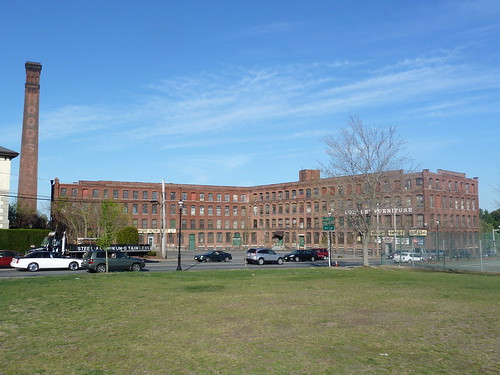Patent Medicine in Lowell: Charles I Hood
Recent news about the “compounding pharmacy” that provided tainted drugs that have now led to dozens of cases of meningitis got me thinking about the US Pharmaceutical Industry which had its roots in Lowell, a national leader in medicine production in nineteenth century America. One of the largest manufacturers was the C.I. Hood Company.

Charles I Hood Patent Medicine Factory
Charles Ira Hood was born in 1845 in Chelsea, a small Vermont town, where his father had an apothecary shop. After finishing his schooling at age fifteen he came to Lowell with hardly a penny to his name to apprentice in Samuel Kidder’s drugstore, where he remained five years. At age twenty he went to Boston to work as a prescription clerk for Theodore Metcalf & Company, 39 Tremont Street, where he learned the mail order business. At age 25, he returned to Lowell and opened his own drugstore at the corner of Merrimack and Central streets. James C. Ayer was his landlord. He became ill in 1920 and died in Lowell on February 4, 1922, age seventy-seven years. His patent medicine company did not long survive his death.
In 1876, Charles followed the lead of J.C. Ayer & Company and began to compound his own sarsaparilla medicine. In addition to sarsaparilla root, he mixed in dandelion, gentian, juniper berries and 18% alcohol. He claimed great success in curing a variety of disorders including “purifying the blood”, heart diseases, dropsy, rheumatism and scrofula. Within two years of launching his product he was on his way to great success. Charles Hood added to his success with Hood’s Tooth Powder, Vegetable Pills, Oil Ointment, Medicated Soap, Dyspeplets (for dyspepsia), TusSamo (for cough) and Hood’s Lotion.
Business was so brisk that Charles Hood needed a larger space. In 1882, he built the four-story Hood’s Laboratories on Thorndike Street, close to the Boston & Lowell railroad depot. He enlarged the laboratories in 1892 and 1897, giving him 175,000 square feet devoted to the manufacture and sale of patent medicines. The first floor was used for storage and freight shipments. The railroad station was easily reached through the back door. The second floor had the advertising and printing offices. All advertising was done on the premises. Here Hood’s printed its calendars, lithographic trade cards and cookbooks. In 1879, seventy million pieces were printed and delivered from these offices. C.I. Hood was the largest single user of the U.S. Mail in Lowell. In addition, C.I. Hood advertisements regularly appeared in newspapers coast to coast. The third floor had the counting room, boiling area and the automatic bottle filler, capable in 1884, of filling 10, 000 bottles a day, and more in later years. The fourth floor held the giant tanks, capable of filling 240,000 bottles. The garden in front of the building was beautifully maintained with 2-3,000 tulips.

Charles I Hood grave, Lowell Cemetery
Great post!
Very nice. I like these ‘old Lowell’ posts.
So what is the future of this building? Given its location residential or commercial would work but I feel we need more jobs than apartments. It’s realistic that rail commuters from down the line would prefer getting off the train and being at work than having to walk 10 minutes or jump on the subway. Is it for sale?,
I thought the “Hood” on the smoke stake was for Hood milk. Now I know! Thanks for the great post.